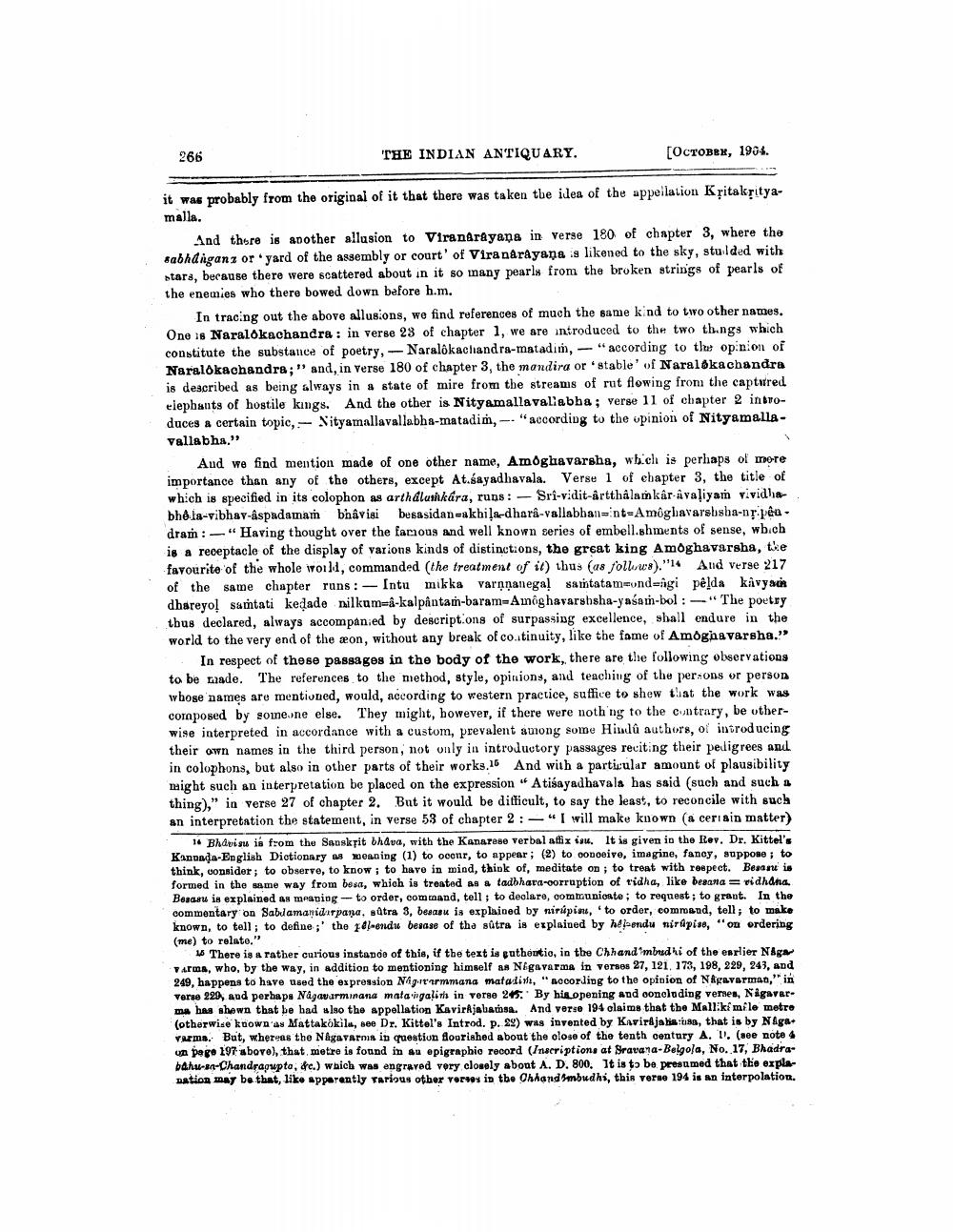________________
266
THE INDIAN ANTIQUARY.
[Остовен, 1904.
it was probably from the original of it that there was taken the idea of the appellation Kritakrityamalla.
And there is another allusion to Viranarayana in verse 180 of chapter 3, where the sabhdiganz or yard of the assembly or court' of Viranarayana is likened to the sky, stulded with stars, because there were scattered about in it so many pearls from the broken strings of pearls of the enemies who there bowed down before h.m.
In tracing out the above allusions, we find references of much the same kind to two other names. One is Naralókachandra: in verse 23 of chapter 1, we are introduced to the two things which constitute the substance of poetry,-Naralôkachandra-matadim, "according to the opinion of Naralókachandra;" and, in verse 180 of chapter 3, the mandira or 'stable' of Naralokachandra is described as being always in a state of mire from the streams of rut flowing from the captured elephants of hostile kings. And the other is Nityamallavaliabha; verse 11 of chapter 2 introduces a certain topic,- Nityamallavallabha-matadim, "according to the opinion of Nityamalla
vallabha."
Aud we find mention made of one other name, Amoghavarsha, which is perhaps of more importance than any of the others, except At.sayadhavala. Verse 1 of chapter 3, the title of which is specified in its colophon as arthálunkára, runs: Sri-vidit-ârtthalam kâr âvaliyam vividhabhê-la-vibhav-aspadamam bhâvisi besasidan akhila-dharâ-vallabhan-int-Amôghavarshsha-nr pêndram:-"Having thought over the famous and well known series of embell.shments of sense, which is a receptacle of the display of varions kinds of distinctions, the great king Amoghavarsha, the favourite of the whole world, commanded (the treatment of it) thus (as follows)."14 And verse 217 of the same chapter runs: Intu mikka varṇnanegal samtatam-ond-igi pêlda kavyan dhareyol samtati kedade nilkum-â-kalpântam-baram-Amoghavarshsha-yasam-bol:"The poetry thus declared, always accompanied by descriptions of surpassing excellence, shall endure in the world to the very end of the son, without any break of continuity, like the fame of Amoghavarsha.""
In respect of these passages in the body of the work, there are the following observations to be made. The references to the method, style, opinions, and teaching of the persons or person whose names are mentioned, would, according to western practice, suffice to shew that the work was composed by someone else. They might, however, if there were nothing to the contrary, be otherwise interpreted in accordance with a custom, prevalent among some Hindû authors, of introducing their own names in the third person, not only in introductory passages reciting their pedigrees and in colophons, but also in other parts of their works, 15 And with a particular amount of plausibility might such an interpretation be placed on the expression "Atisayadhavala has said (such and such a thing)," in verse 27 of chapter 2. But it would be difficult, to say the least, to reconcile with such an interpretation the statement, in verse 53 of chapter 2: "I will make known (a certain matter)
-
14 Bhavisu is from the Sanskrit bhava, with the Kanarese verbal affix isu. It is given in the Rev. Dr. Kittel's Kannada-English Dictionary as meaning (1) to occur, to appear; (2) to conceive, imagine, fancy, suppose; to think, consider; to observe, to know; to have in mind, think of, meditate on; to treat with respect. Besasu is formed in the same way from besa, which is treated as a tadbhara-corruption of ridha, like besana vidhana.. Besasu is explained as meaning to order, command, tell; to deolare, communicate; to request; to grant. In the commentary on Sabdamanidarpana, sûtra 3, besasu is explained by nirúpisu, to order, command, tell; to make known, to tell; to define; the 14-endu besase of the sûtra is explained by helendu nirûpise, "on ordering (me) to relate."
15 There is a rather curious instance of this, if the text is guthentic, in the Chhand'mbudhi of the earlier Naga Varma, who, by the way, in addition to mentioning himself as Nigavarma in verses 27, 121, 173, 198, 229, 243, and 249, happens to have used the expression Nigrarmmana matadim, "according to the opinion of Nagavarman," in verse 229, and perhaps Nagavarminana matangalih in verse 245. By his opening and concluding verses, Nagavarma has shown that be had also the appellation KavirAjabamsa. And verse 194 claims that the Malliki mile metre (otherwise known as Mattakokila, see Dr. Kittel's Introd. p. 22) was invented by Kaviraja hausa, that is by Niga varma. But, whereas the Nagavarma in question flourished about the close of the tenth century A. 1. (see note 4 on page 197 above), that, metre is found in au epigraphic record (Inscriptions at Sravana-Belgola, No. 17, Bhadrabahu-sa-Chandragupta, &c.) which was engraved very closely about A. D. 800. It is to be presumed that the explanation may be that, like apparently various other verses in the Chhand 5mbudhi, this verse 194 is an interpolation.




